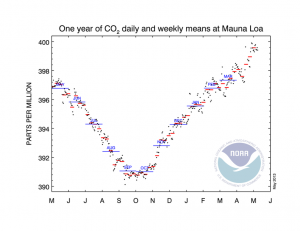 Alarming news on the climate change front this Friday. Scientific measurements show that the heat-trapping gas has now reached an average daily level above 400 parts per million (ppm) for the first time in three million years. This raises the prospects of drastic climatic shifts and higher sea levels.
Alarming news on the climate change front this Friday. Scientific measurements show that the heat-trapping gas has now reached an average daily level above 400 parts per million (ppm) for the first time in three million years. This raises the prospects of drastic climatic shifts and higher sea levels.
The milestone was reached on May 9. Measurements, which began in 1958, are taken in the atmosphere of Mauna Loa, Hawaii (top left photo). Independent measurements made by both the National Oceanic and Atmospheric Administration and the Scripps Institution of Oceanography have been approaching this level during the past week. Mauna Loa is the oldest continuous carbon dioxide (CO2) measurement station in the world, and is the primary global benchmark site for monitoring the increase of greenhouse gas.

The concentration of carbon dioxide has increased every year since scientists started making measurements on the slopes of the Mauna Loa volcano more than five decades ago. The rate of increase has accelerated since the measurements started, from about 0.7 ppm per year in the late 1950s to 2.1 ppm per year during the last 10 years.
“That increase is not a surprise to scientists,†said NOAA senior scientist Pieter Tans, with the Global Monitoring Division of NOAA’s Earth System Research Laboratory in Boulder, Colo.
Driving the increase in carbon dioxide concentration is our reliance on fossil fuels. “The evidence is conclusive that the strong growth of global CO2 emissions from the burning of coal, oil, and natural gas is driving the acceleration,” he added.
Before the Industrial Revolution in the 19th century, global average CO2 was about 280 ppm. During the last 800,000 years, CO2 fluctuated between about 180 ppm during ice ages and 280 ppm during interglacial warm periods. Today’s rate of increase is more than 100 times faster than the increase that occurred when the last ice age ended.
It was researcher Charles David Keeling of the Scripps Institution of Oceanography, UC San Diego, who began measuring carbon dioxide at Mauna Loain 1958, initiating now what is known as the “Keeling Curve.†His son, Ralph Keeling, also a geochemist at Scripps, has continued the Scripps measurement record since his father’s death in 2005.
Once emitted, CO2 added to the atmosphere and oceans remains for thousands of years. Thus, climate changes forced by CO2 depend primarily on cumulative emissions, making it progressively more and more difficult to avoid further substantial climate change.
The new data gives us a pause for thought about expansionist economic models and the source of energy that powers the world’s economy. Alternative energy is part of the mix of solutions we should be pursuing to create a sustainable future. They are cleaner, renewable and decentralized, but at this stage they need stronger official policies to reach economic sustainability.
Source: NOAA
Sponsored video:





